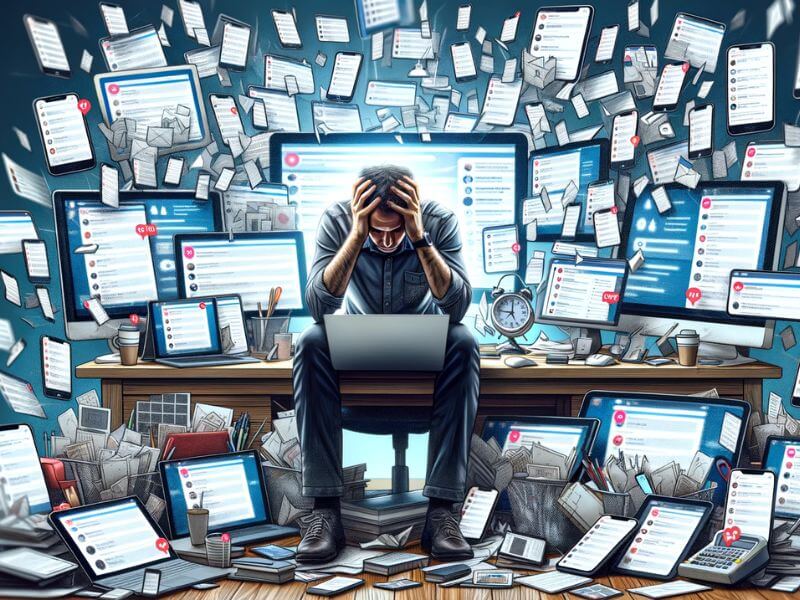Digital Wellness: Navigating Life in the Age of Information Overload
Do you ever feel like you’re drowning in a sea of emails, notifications, and social media updates? In today’s digital age, it’s easy to get overwhelmed by the constant stream of information coming at you.
That’s why it’s more important than ever to take control of your digital wellness. In the book ‘Digital Wellness: Navigating Life in the Age of Information Overload’, you’ll discover practical strategies for managing the onslaught of digital distractions and finding a healthy balance between your online and offline activities.
Learn how to recognize the signs of digital overwhelm, set boundaries with technology, and practice mindfulness in a digital world. Take the first step towards a healthier relationship with technology and reclaim your time and focus.
Recognizing the Signs of Digital Overwhelm
To effectively navigate life in the age of information overload, it’s crucial for you to be aware of the signs of digital overwhelm. With constant access to emails, social media notifications, and news updates, it’s easy to become overwhelmed by the sheer amount of information bombarding you daily.
One of the first signs of digital overwhelm is feeling a constant need to check your phone or other devices. You may find yourself reaching for your phone even when you don’t have any notifications.

Another sign is feeling anxious or stressed when you’re unable to access the internet or your digital devices. This could manifest as a sense of unease or even panic.
Additionally, experiencing difficulty in focusing or staying present in the moment can be a sign of digital overwhelm. You may find yourself constantly multitasking or having a hard time concentrating on one task at a time.
Recognizing these signs is the first step in managing digital overwhelm and taking control of your digital well-being. By being aware of these signs, you can proactively take steps to create a healthier digital balance in your life.
Setting Boundaries With Technology
Setting boundaries with technology is essential for maintaining a healthy digital balance in your life. In today’s hyperconnected world, it’s easy to become overwhelmed and consumed by the constant stream of information and notifications. By setting boundaries, you can regain control over your time, attention, and overall well-being.
One effective boundary to establish is designating specific times for technology use. Allocate dedicated periods for checking emails, browsing social media, or engaging in other online activities. Outside of these designated times, make a conscious effort to disconnect and focus on other aspects of your life.

Another boundary to consider is limiting the use of technology in certain environments or situations. For example, you could establish a rule of no technology during meals or family gatherings. This allows you to fully engage with the present moment and connect with those around you.
Additionally, setting boundaries around the types of content you consume can be beneficial. Be mindful of the information you expose yourself to and consider the impact it has on your mental and emotional well-being. Unfollow accounts or unsubscribe from newsletters that don’t align with your values or contribute to your personal growth.
Practicing Mindfulness in a Digital World
In order to cultivate mindfulness in a digital world, it’s crucial for you to be intentional about your online interactions. With the constant influx of information and distractions, it can be easy to get caught up in the digital noise and lose touch with the present moment. Mindfulness is about being fully aware and engaged in the present, and it can greatly benefit your well-being in the digital age.
One way to practice mindfulness in a digital world is to set boundaries and establish designated tech-free times and spaces. Create a daily routine that includes moments of digital detox, such as turning off your devices during meals or before bedtime. This will allow you to disconnect from the virtual world and reconnect with yourself and the people around you.

Another important aspect of mindfulness is being aware of your online behavior and the impact it has on your mental and emotional state. Take the time to reflect on how your online interactions make you feel. Are they uplifting and positive, or do they leave you feeling drained and anxious? Being mindful of the content you consume and the people you engage with can help you create a healthier digital environment for yourself.
Lastly, practicing mindfulness in a digital world also means being present and engaged in your online activities. Instead of mindlessly scrolling through social media or browsing the internet, be intentional about how you spend your time online. Focus on activities that bring you joy, inspire you, or promote personal growth. By being mindful of your online interactions, you can foster a healthier relationship with technology and find balance in the digital age.
Finding a Healthy Balance Between Online and Offline Activities
Create a balance between your online and offline activities by actively prioritizing and managing your time. In today’s digital age, it’s easy to get caught up in the constant stream of information and online interactions. However, it’s important to remember the value of offline activities and find a healthy balance between the two.
Start by setting clear boundaries for yourself. Determine specific times for both online and offline activities, and stick to them. This will help you avoid spending excessive time online and neglecting other aspects of your life.

Another helpful strategy is to prioritize your activities based on their importance and impact on your overall well-being. Identify the activities that bring you joy, fulfillment, and growth, both online and offline. Make sure to allocate sufficient time for these activities, while minimizing time spent on less meaningful or productive ones.
Additionally, make an effort to engage in offline activities that promote physical and mental well-being. This could include exercising, spending time with loved ones, pursuing hobbies, or simply enjoying nature. These offline experiences can provide a much-needed break from the digital world and help you recharge.
Strategies for Managing Information Overload
To effectively manage information overload, prioritize and filter the content you consume based on your specific needs and goals. With the constant influx of information, it’s essential to establish a system that helps you stay focused and organized.
Start by identifying your priorities and determining what information is most relevant to your life or work. This will enable you to allocate your time and attention more effectively.

One strategy is to set specific goals for the information you consume. Ask yourself what you hope to achieve by consuming certain content. Are you looking for inspiration, knowledge, or practical tips? By clarifying your objectives, you can filter out irrelevant information and focus on what truly matters to you.
Additionally, take advantage of technology tools and applications that can assist you in managing information overload. There are numerous apps available that can help you organize and categorize information, such as note-taking apps, bookmarking tools, and content aggregators. Find the ones that suit your needs and make use of them to streamline your information consumption process.
Conclusion
In conclusion, navigating life in the age of information overload requires recognizing the signs of digital overwhelm, setting boundaries with technology, practicing mindfulness, and finding a healthy balance between online and offline activities. It’s essential to manage information overload by implementing effective strategies. By prioritizing digital wellness and taking control of your online habits, you can maintain a healthy relationship with technology and lead a more balanced and fulfilling life.







